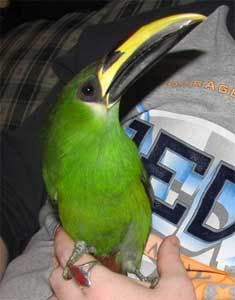The emerald toucanet is a member of the toucan family ramphastidae, its range stretches from central to South America.
| Species Name | |
|---|---|
 |
|
| image credit if needed | |
| Classification | |
| Order | piciformes |
| Family | ramphasitdae |
| Subfamily | NA |
| Genus | Aulacorhynchus |
| Species | prasinus |
| Aviculture | |
| Noise level | quiet |
| Skill level | Intermediate |
| Size | medium |
| Price | high $1000-1500 typically |
| Maintenance | medium-high |
| Talking | no talking ability |
Description
The emerald toucanet is as the name suggests a relatively small toucan. This bird weighs around 175-180 grams. Like all toucans, perhaps the most immediately notable feature of this bird is its beak, which is very large for its body size. All emerald toucanet subspecies have green plumage, but bill pattern, and throat coloration vary.
Emerald toucanets are not generally considered to be sexually dimorphic, but this isn't strictly speaking the case, males tend to be notably larger and have proportionally longer bills than females. Sexing toucanets in this way is possible, though not perfect.
In the wild
Emerald toucanets are primarily frugivores, that is fruit eaters, however in addition to a variety of
fruits they will also consume flowers, insects, arachnids, birds eggs, and they will prey upon
adult birds on occasion as well.
As companion pets
Emerald toucanets have very energetic, playful, and even clownish personalities, and like many toucans tame ones are known for enjoying being held and pet. They tend to be very curious, and enjoy a lot of human attention. They seldom become one person birds as many parrots do. The can be taught tricks, such as to catch an object tossed at them, and potty training is possible with this species.
As aviary birds
Emerald toucanets should not be housed with other bird species. Birds do make up a small portion
of the toucanet's diet in the wild, and similar sized and smaller species of bird are likely to be seen as prey. Emerald toucanets are aggressive and may harass larger birds, or simply play too rough, and there is the risk of hookbills being agitated by them. If you plan to have your emerald toucanet out with your other birds please supervise them closely.
Diet and health
Emerald toucanets must be fed fresh fruit daily. The bulk of their fruit should ideally be
made up of items such as papaya (can be substituted with cantaloupe and similar melon), blueberries, and banana. It is best to give them a wide variety of fruit, such as blackberries, pomegranate, various melons, etc… However they must not be offered citrus or other particularly acidic food items. Toucanets suffer from a tendency for hemochromatosis, or iron storage disease, and must be fed a low iron diet, which includes a low iron softbill pellet. They may also be fed hibiscus flowers, and insects as a treat, but take care that they do not try to eat bees, and other stinging insects, or slugs, snails, sowbugs and worms because they may carry parasites.
Breeding
The breeding of this species is difficult, but has been successful. They require an aviary for breeding, the minimum aviary size for a pair is debatable, but length is important, and I suggest against going smaller than 6 feet, more is better, and observe birds carefully, especially when first introduced. These birds are prone to mate aggression, and if this appears pairs may need to be separated for at least a time, however giving the birds a larger living space may also solve this problem.
Mutations
There are no known mutations, but several subspecies.
Gallery
See also
External Links
List related and helpful external links here. Example:
http://www.emeraldforestbirds.com/
http://softbillsforsale.com/articles/toucans.asp
http://slybird.blogspot.com/2008/05/how-many-toucanets-part-1.html
http://toucanets.com/
http://pets.groups.yahoo.com/group/TOUCANS_RAMPHASTIDS/











